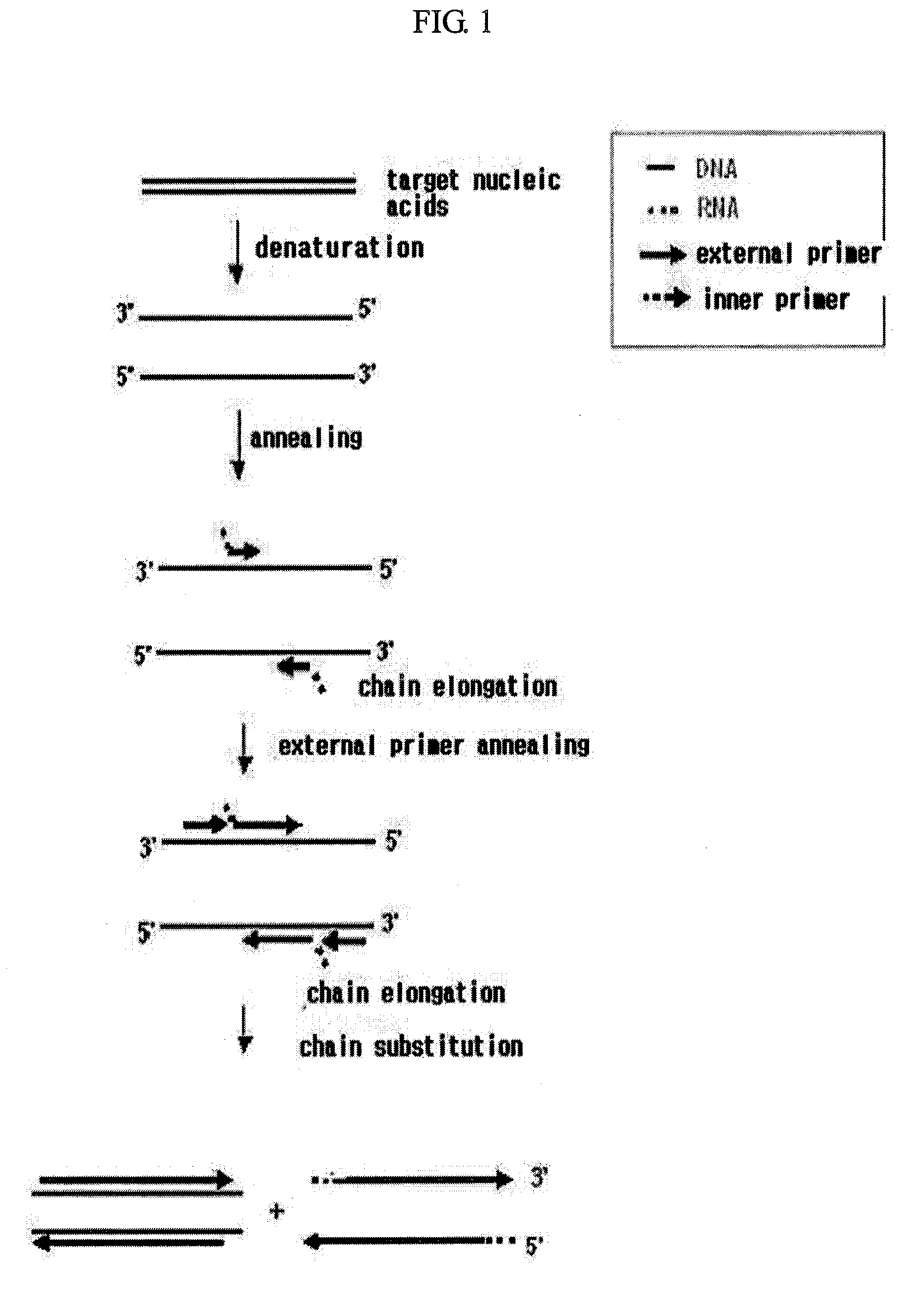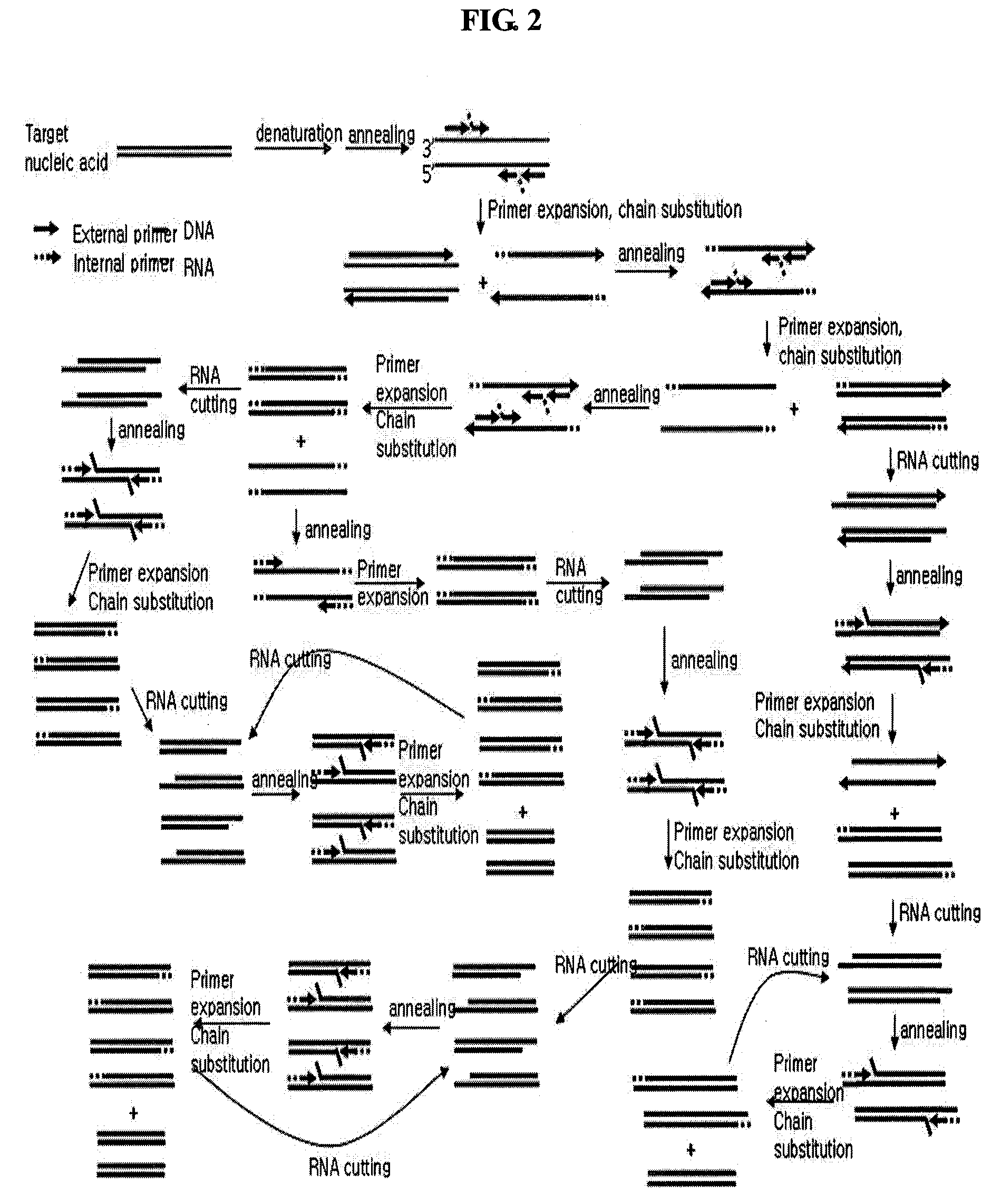Method for isothermal amplification of nucleic acids and method for detecting nucleic acids using simultaneous isothermal amplification of nucleic acids and signal probe
a nucleic acid and isothermal amplification technology, applied in the field of isothermal amplification of nucleic acids and a detection method, can solve the problems of low copy number, inability to detect a short sequence on the chromosomal dna, and difficulty in solving the problem
- Summary
- Abstract
- Description
- Claims
- Application Information
AI Technical Summary
Benefits of technology
Problems solved by technology
Method used
Image
Examples
example 1
Isothermal Amplification of Nucleic Acids
[0074]Lambda DNA (TaKaRa Bio Inc.; 3010, 0.3 μg / ml) was used as target nucleic acids, an external primer and RNA / DNA hybrid inner primer were prepared by referring to whole base sequences of lambda DNA (GenBank No. J02459) and the conventional methods (Biochem. Biophy. Res. Comm., 289:150, 2001).
[0075]The external primer was designed such that it comprises sequences complementary to the lambda DNA, and the sequences are SEQ ID NOs: 1 or 2 as follows:
SEQ ID NO: 1:5′-GGACGTCAGAAAACCAGAA-3′SEQ ID NO: 2:5′-GGCAGTGAAGCCCAGAT-3′
[0076]RNA / DNA hybrid inner primer was designed such that oligoRNA region thereof has a sequence non-complementary to lambda DNA, and oligoDNA region thereof has a sequence complementary to lambda DNA, and the sequences are SEQ ID NOs: 3 and 4 as follows (the oligoRNA regions are underlined):
SEQ ID NO: 3:5′-UAAGAGAUCGCCCGUCAGCCGCTCCGATCACCCTCGCAAAC-3′SEQ ID NO: 4:5′-CAACAUGACCGACGCUUGCCCGCGCCACGCTCCTTAATCTG-3′
[0077]In order t...
example 2
Isolation of Nucleic Acids from E. coli 0157:H7
[0082]E. coli 0157:H7 (KCCM 40406) was cultured in a suitable medium (Trypticase soy broth) at 37° C. under aerobic condition, from which cell culture broth was taken every hour to measure the absorbance and cell number. After carrying out a technique of diluting cell culture broth continuously in a liquid medium, cell number was enumerated according to absorbance using Helber cell counting chamber.
[0083]Isolation of nucleic acids in E. coli 0157:H7 was performed using G-spin Genomic DNA isolation system of Intron Inc (Cat NO: 17121). The isolation is as follows: 1.0 ml of bacteria culture broth at the logarithmic phase was taken to adjust to a concentration of 107 cells / ml, the cells obtained by centrifuging at 13,000 g for 2 min was added with 300 ml of G-buffer solution to resuspend, and then left to stand for 15 min at 65° C., to which 250 ml of binding buffer was added to suspend smoothly. The binding buffer contains RNase solution...
example 3
Preparation of Gold Nanocolloid [Diameter: 42 nm]
[0084]Synthesis of gold nanoparticle is performed using the conventional method known in the art (Liu et al., J. Am. Chem. Soc., 126:12299, 2004). The method is as follows: 200 ml of 0.3 mM HAuCl4 (Aldrich, USA) was added into a flask and heated to stir, and then 1.8 ml of 38.8 mM sodium citrate (Aldrich, USA) was dropwised rapidly. The reaction mixture whose color changed from pale yellow to deep purple, was heated for 10 min to stir for 15 min while cooling it to room temperature when it became pale red, thus obtaining gold nanoparticle solution with a diameter of 42 nm showing a maximum UV absorbance at 520 nm.
PUM
| Property | Measurement | Unit |
|---|---|---|
| Temperature | aaaaa | aaaaa |
| Length | aaaaa | aaaaa |
| Fluorescence | aaaaa | aaaaa |
Abstract
Description
Claims
Application Information
 Login to View More
Login to View More - R&D
- Intellectual Property
- Life Sciences
- Materials
- Tech Scout
- Unparalleled Data Quality
- Higher Quality Content
- 60% Fewer Hallucinations
Browse by: Latest US Patents, China's latest patents, Technical Efficacy Thesaurus, Application Domain, Technology Topic, Popular Technical Reports.
© 2025 PatSnap. All rights reserved.Legal|Privacy policy|Modern Slavery Act Transparency Statement|Sitemap|About US| Contact US: help@patsnap.com



